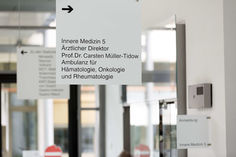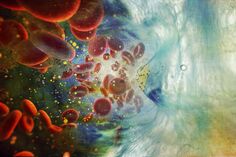CLINICAL TRIAL SERVICES - DIAGNOSTICS
We are an innovation-oriented partner in the field of hemato-immuno-oncological diagnostics and accompanying immune-monitoring in the context of preclinical and clinical trials.
We are happy to assist you with reliable flow cytometry and routine molecular diagnostics. Modern approaches and many years of cooperation with scientific institutions and pharmaceutical companies underline our expertise in the development of unique and validated methods for potential immunotherapies.
Basic scientific research projects (from target identification to clinical evaluation including the use of transcriptional high-throughput sequencing approaches), also in the context of clinical trials, can be realized together with the Translational Immunology Lab (Clinical Trial services: Research).

Head of Group
SPECTRUM OF METHODS
Flow Cytometry
Flow Cytometry allows us to characterize a large number of single cells in a short amount of time regarding their surface and intracellular antigens. Using this high throughput method allows us to present complex results from various sample sources (including blood, bone marrow, cerebrospinal fluid and solid tissues after preparation).
MULTIPARAMETER FLOW CYTOMETRY
The bandwidth of hematological malignancies requires an analysis method to characterize the complex biomarker combinations needed for a diagnosis. We use modern 8-10 color flow cytometers which are capable of performing these multiparametric analyses.
IMMUNOPROFILING
By describing the composition of the patient’s immune system, we can support and learn more about immune modulatory therapies (IMID) in hematological malignancies.
TARGETING
By characterizing the cells’ surface markers we can detect targets for new chemotherapies, new drug conjugated antibodies and CAR-T-cell therapies on cell samples of relapsed patients and are able to give a fast feedback to the clinicians concerning the possibility for the use of these new promising therapy options.
Together with our Translational Immunology Lab we develop possible new targets.
NEXT GENERATION FLOW
The detection of minimal residual disease requires cutting edge technology to detect very small numbers of residual cells of the primary malignancy. After analyzing the cells in our modern flow cytometers, we use highly innovative semi-automated software tools to further characterize the samples. This method allows a prognostic assessment early on.
Molecular Genetics
Based on the mutation(s) of interest we are able to select the appropriate method (see below) for analysis and to establish the analysis including suitable controls.
PCR (polymerase chain reaction)
PCR is our basic method used to amplify regions of interest which can be analyzed further using various approaches (see below). Specificity of the amplified products is based on the selection of specific primers. During PCR the region of interest is amplified exponentially which allows further analysis as well as the detection of rare events.
Multi-plex PCR
Since genomic rearrangements can occur within different breakpoint regions of genes, multi-plex PCR uses various primers covering different breakpoint regions in a single PCR reaction. This enables us to detect different genomic rearrangements very efficiently. This method is used to detect genomic rearrangements not necessarily leading to an enhanced expression and short intronic sequences.
Long Range PCR
This method allows the amplification of genomic rearrangements leading to PCR products up to 20 kb. This method is used to detect genomic rearrangements not necessarily leading to an enhanced expression and long intronic sequences.
RT-PCR (reverse transcription PCR)
RT-PCR is used to detect genomic rearrangements based on RNA. Since intronic sequences which can be very long are only present in genomic DNA but absent in mRNA, using RNA, which has to be reverse transcribed into cDNA, as template allows to amplify genomic rearrangements more efficiently. This method is used for the detection of genomic rearrangements with large intronic sequences where the genomic rearrangement leads to an enhanced expression of the fusion gene.
Real-time PCR
Real-Time PCR is used to quantify specific transcripts either to measure expression levels of genes of interest or to calculate the amount of specific transcripts compared to a reference gene. Target detection is based on fluorescence signals which are measured at the end of every single PCR cycle. Dependent on the amount of target present in the real-time PCR reaction the fluorescence signal crosses the determined threshold at different PCR cycles. The PCR cycle at which the threshold is crossed is used for quantification.
Digital droplet PCR
Digital droplet PCR is a method for detection and quantification of rare events by fluorescence. Due to its very high sensitivity compared to Sanger Sequencing digital droplet PCR can be used to monitor minimal residual disease as well as to determine allelic frequencies of mutations which might have a prognostic impact.
Sanger Sequencing
Sanger Sequencing is used to determine the nucleotide sequence of a region of interest. This method is suitable if there might be mutations at different nucleotides within a defined region as well as to determine the precise mutation if there various mutations possible at a single nucleotide position.
NGS (Next Generation Sequencing)
Next generation sequencing is employed to analyze the nucleotide sequence of various genes or parts of various genes of different patients in a single experiment. By this, a huge amount of sequencing data is generated in order to identify mutations within different genes which might contribute to disease development or allows a prognostic assessment.
OUR EXPERTISE
The following preclinical and clinical trials were and are accompanied by our laboratory with minimal residual disease assessment and advanced immune profiling portfolio:
- GMMG HD6, multiple myeloma phase III clinical trial
- GMMG HD7, multiple myeloma phase III clinical trial
- GMMG HD8, multiple myeloma phase III clinical trial
- GMMG HD9, multiple myeloma phase III clinical trial
- GMMG HD10, multiple myeloma phase II clinical trial
- GMMG CONCEPT, multiple myeloma phase II clinical trial
- GMMG DaDa, multiple myeloma phase II clinical trial
- AML: Q-SOC (HeLeNe 20-04), phase III clinical trial
- AML:Q-HAM (HeLeNe 18-03), phase II clinical trial
- AML:GnG (HeLeNe 18-02), phase III clinical trial
- AML: TEAM, phase II clinical trial
OUR PUBLICATIONS
Kriegsmann K, Ton GNHQ, Awwad MHS, Benner A, Bertsch U, Besemer B, Hänel M, Fenk R, Munder M, Dürig J, Blau IW, Huhn S, Hose D, Jauch A, Mann C, Weinhold N, Scheid C, Schroers R, von Metzler I, Schieferdecker A, Thomalla J, Reimer P, Mahlberg R, Graeven U, Kremers S, Martens UM, Kunz C, Hensel M, Seidel-Glätzer A, Weisel KC, Salwender HJ, Müller-Tidow C, Raab MS, Goldschmidt H, Mai EK, Hundemer M.
CD8+ CD28- regulatory T cells after induction therapy predict progression-free survival in myeloma patients: results from the GMMG-HD6 multicenter phase III study. Leukemia . 2024 Jul
Jaramillo S, Scherer M, Szu-Tu C, Beneyto-Calabuig S, Müller-Tidow C, Schlenk RF, Hundemer M, Velten L, Pabst C.
Late-onset NPM1 mutation in a MYC-amplified relapsed / refractory acute myeloid leukemia patient treated with gemtuzumab ozogamicin and glasdegib. Haematologica. 2024 May
Leypoldt LB, Tichy D, Besemer B, Hänel M, Raab MS, Mann C, Munder M, Reinhardt HC, Nogai A, Görner M, Ko YD, de Wit M, Salwender H, Scheid C, Graeven U, Peceny R, Staib P, Dieing A, Einsele H, Jauch A, Hundemer M, Zago M, Požek E, Benner A, Bokemeyer C, Goldschmidt H, Weisel KC.
Isatuximab, Carfilzomib, Lenalidomide, and Dexamethasone for the Treatment of High-Risk Newly Diagnosed Multiple Myeloma. J Clin Oncol. 2024 Jan
John L, Miah K, Benner A, Mai EK, Kriegsmann K, Hundemer M, Kaudewitz D, Müller-Tidow C, Jordan K, Goldschmidt H, Raab MS, Giesen N.
Impact of novel agent therapies on immune cell subsets and infectious complications in patients with relapsed/refractory multiple myeloma. Front Oncol. 2023 Apr
Beneyto-Calabuig S, Merbach AK, Kniffka JA, Antes M, Szu-Tu C, Rohde C, Waclawiczek A, Stelmach P, Gräßle S, Pervan P, Janssen M, Landry JJM, Benes V, Jauch A, Brough M, Bauer M, Besenbeck B, Felden J, Bäumer S, Hundemer M, Sauer T, Pabst C, Wickenhauser C, Angenendt L, Schliemann C, Trumpp A, Haas S, Scherer M, Raffel S, Müller-Tidow C, Velten L.
Clonally resolved single-cell multi-omics identifies routes of cellular differentiation in acute myeloid leukemia. Cell Stem Cell. 2023 May
Kriegsmann K, Manta C, Schwab R, Mai EK, Raab MS, Salwender HJ, Fenk R, Besemer B, Dürig J, Schroers R, von Metzler I, Hänel M, Mann C, Asemissen AM, Heilmeier B, Bertsch U, Huhn S, Müller-Tidow C, Goldschmidt H, Hundemer M.
Comparison of bone marrow and peripheral blood aberrant plasma cell assessment by NGF in patients with MM. Blood Adv. 2023 Feb
Tirier SM, Mallm JP, Steiger S, Poos AM, Awwad MHS, Giesen N, Casiraghi N, Susak H, Bauer K, Baumann A, John L, Seckinger A, Hose D, Müller-Tidow C, Goldschmidt H, Stegle O, Hundemer M, Weinhold N, Raab MS, Rippe K.
Subclone-specific microenvironmental impact and drug response in refractory multiple myeloma revealed by single-cell transcriptomics. Nat Commun. 2021 Nov
Legscha KJ, Antunes Ferreira E, Chamoun A, Lang A, Awwad MHS, Ton GNHQ, Galetzka D, Guezguez B, Hundemer M, Bourdon JC, Munder M, Theobald M, Echchannaoui H.J
Δ133p53α enhances metabolic and cellular fitness of TCR-engineered T cells and promotes superior antitumor immunity. Immunother. Cancer. 2021 Jun
Awwad MHS, Mahmoud A, Bruns H, Echchannaoui H, Kriegsmann K, Lutz R, Raab MS, Bertsch U, Munder M, Jauch A, Weisel K, Maier B, Weinhold N, Salwender HJ, Eckstein V, Hänel M, Fenk R, Dürig J, Brors B, Benner A, Müller-Tidow C, Goldschmidt H, Hundemer M.
Selective elimination of immunosuppressive T cells in patients with multiple myeloma. Leukemia. 2021 Sep
Mougiakakos D, Bach C, Böttcher M, Beier F, Röhner L, Stoll A, Rehli M, Gebhard C, Lischer C, Eberhardt M, Vera J, Büttner-Herold M, Bitterer K, Balzer H, Leffler M, Jitschin S, Hundemer M, Awwad MHS, Busch M, Stenger S, Völkl S, Schütz C, Krönke J, Mackensen A, Bruns H.
The IKZF1-IRF4/IRF5 Axis Controls Polarization of Myeloma-Associated Macrophages. Cancer Immunol Res. 2021 Mar
Kriegsmann K, Hundemer M, Hofmeister-Mielke N, Reichert P, Manta CP, Awwad MHS, Sauer S, Bertsch U, Besemer B, Fenk R, Hänel M, Munder M, Weisel KC, Blau IW, Neubauer A, Müller-Tidow C, Raab MS, Goldschmidt H, Huhn S, For The German-Speaking Myeloma Multicenter Group Gmmg.
Comparison of NGS and MFC Methods: Key Metrics in Multiple Myeloma MRD Assessment. Cancers (Basel). 2020 Aug
Roider T, Seufert J, Uvarovskii A, Frauhammer F, Bordas M, Abedpour N, Stolarczyk M, Mallm JP, Herbst SA, Bruch PM, Balke-Want H, Hundemer M, Rippe K, Goeppert B, Seiffert M, Brors B, Mechtersheimer G, Zenz T, Peifer M, Chapuy B, Schlesner M, Müller-Tidow C, Fröhling S, Huber W, Anders S, Dietrich S.
Dissecting intratumour heterogeneity of nodal B-cell lymphomas at the transcriptional, genetic and drug-response levels. Nat Cell Biol. 2020 Jul
COLLABORATIONS
- DKFZ/Biostatistics (Axel Benner)
- EMBL (Genomics and Proteomics Core Facilities)
- GMMG Study Group
- BD Biosciences, Cytognos S. L. – Flow Cytometry Solutions (Salamanca, Spain)
- University of Navarra/ Flow Cytometry in Multiple Myeloma (Bruno Paiva)







